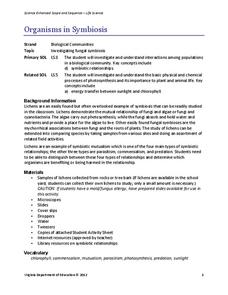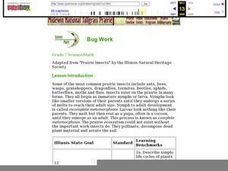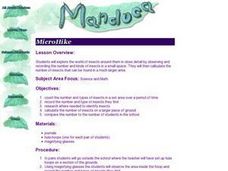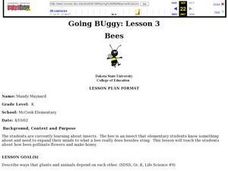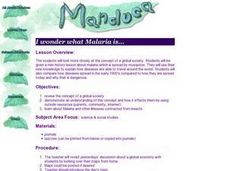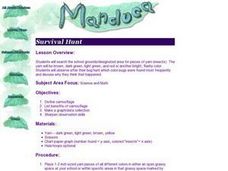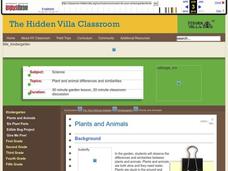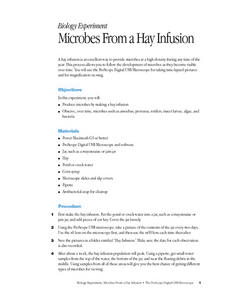Ask a Biologist
The Many Faces of Ants
Though they be but little, they are fierce! Young biologists read about eight different species of ants, and discover how the anatomy of their heads can explain the way they live and what they eat.
National Security Agency
Place Value - Butterflies Floating Place to Place
Learn about butterflies and place value in a series of interdisciplinary lessons! With several worksheets that reference butterfly facts in word problems, kids can practice science and math in one activity. Additional worksheets are...
Virginia Department of Education
Organisms in Symbiosis
Searching for an activity that allows emerging biologists to explore symbiosis up close and personal? Pupils collect samples and view lichens through a microscope and conclude with a discussion about the relationship they have with other...
Curated OER
Science Vocabulary: Grade 3
Third graders will be able to tell you all the parts of the life cycle after viewing this presentation. This series of slides contains single words related to the life cycle and simple definitions of each. Note: Adding vivid images would...
Curated OER
Are You One Of Us?
Students discover how to classify things based on their similarities and differences. Students give the characteristics of insects and create a classification list. Given examples of various types of insects, students classify them...
Curated OER
A Day in the life of...
Young scholars read about and study insects--their distinguishing characteristics, habitats, camouflage methods, defense mechanisms, etc. They draw pictures and write a story from the viewpoint of an insect and share their pictures and...
Curated OER
Are You One of Us?
Learners compare and contrast insects and arthropods, identifying characteristics of each. In groups, they sort pictures of arthropods into the five different classes of arthropods. They also sort pictures into insect and non-insect piles.
Curated OER
Bug Work
Students explore the life cycles of insects and how they interact with each other in the prairie to create a healthy ecosystem and viable food chain. They list animals or insects in their own community that are similar to the prairie...
Shmoop
ELA - Literacy.CCSS.ELA-Literacy.RST.9-10.6
Key to understanding scientific or technical texts is identifying the underlying question the author is attempting to answer. Provide your young scientists with an opportunity to practice identifying these questions and the procedures...
Curated OER
MicroHike
Middle schoolers observe insects in a small area. They calculate the number of insects in a large area as well. They share their calculations and observations with the class.
Curated OER
I Wonder What Would Happen if Lots of Manduca Lived in a Small Place...
Students discuss the reasons why humans fight and look for similiarties in animals. They make predictions on what they think will happen when they observe insect crowding. They make conclusions about their predictions to end the lesson...
Curated OER
Going Buggy: Lesson 3: Bees
Students review the characteristics of insects they have already been introduced to. As a class, they are introduced to the characteristics of bees and what it can do instead of sting. To end the lesson, they discuss how plants and...
Curated OER
I Wonder What Malaria is
Students examine the disease malaria. They compare how diseases were spread in the early 1900's compared to how they are spread today and discuss why that is dangerous. They take a survey to see how much they know about insects that...
Curated OER
Survival Hunt
Young scholars search for yarn representing insects on school grounds. They discuss which colors where found more frequently and why after the experiment. They use their math skills to determine percentages.
Curated OER
Animals A to Z: Ladybug
In this ladybug learning exercise, 3rd graders will read 10 facts about a ladybug to gain an understanding of the insect's characteristics. Students will locate 10 errors of punctuation, capitalization, spelling, and grammar.
Curated OER
'Don't Let the Bugs Bite' Challenge
In this insect facts learning exercise, students respond to 11 multiple choice questions that require them to exhibit what they know about insects.
Curated OER
Plants and Animals
Students taste test the garden. In this Science lesson, students compare and contrast plants and animals needs. Students pick fruits and vegetables in the garden and discuss their observations.
Curated OER
In the Company of Wild Butterflies
Learners discover the life cycle of a butterfly and explain the different stages. For this exploratory lesson students watch a video and create insect art and they will get an opportunity to view live specimens of butterflies.
Curated OER
How Do We Know These Beetles Are Safe to Use?
Students evaluate the impact beetles have on plants. In groups, they select plants to expose to leaf-feeding beetles and place those beetles on the caged plants. They observe the beetles and discuss the insect and plant interaction...
Curated OER
'Don't Let the Bugs Bite' Vocabulary
For this bug vocabulary skills worksheet, students match the 12 listed insects to the appropriate sentences that describe each of them.
Curated OER
Little Bees, Big Potential
After reading an article on the alfalfa leafcutting bee, learners chart its characteristics alongside those of the honeybee. Then they draw the leafcutter lifecycle. The article provides fascinating reading when studying the role of...
Curated OER
Microbes From a Hay Infusion
Students observe, over time, microbes such as amoebas, protozoa, rotifers and insect larva. They create a hay infusion culture using pond water then sample and record organisms found over a two week period.
Curated OER
Biodiversity
Fifth graders visit the playground to look for signs of life. They search for insects, birds, animal tracks, feathers, nests, trees, soil, etc. They then compose a class list that shows all findings in the schoolyard and post it in the...
Curated OER
I Wonder What That Thing Is On My Manduca
Students use the internet to gather more information on the anatomy of the Manduca. They make predictions of what the insect will look like when it hatches and complete a crossword puzzle to practice their vocabulary. They continue to...
Other popular searches
- Insects Science
- K 2 Life Science Insects
- Parts of Insects Science
- Life Science Insects
- Esl Lessons Science Insects
- Esl Science Insects




